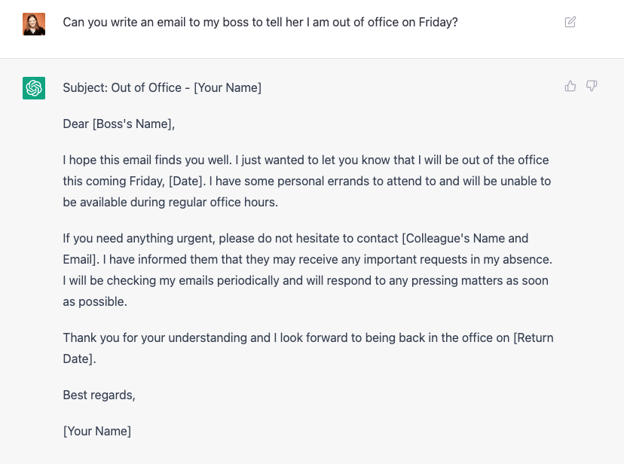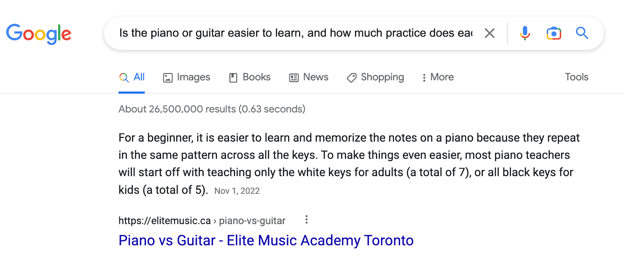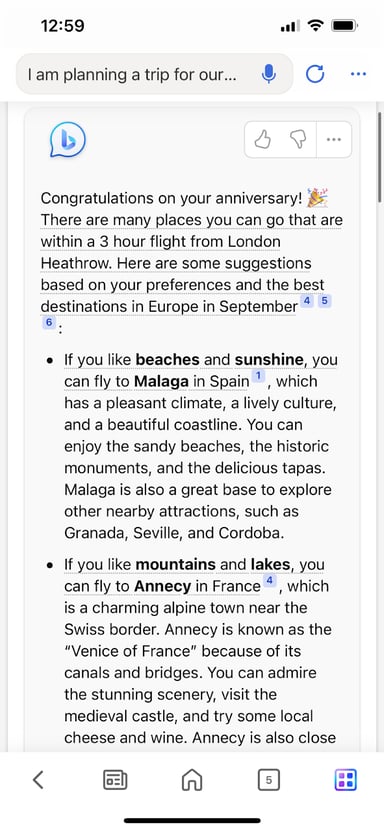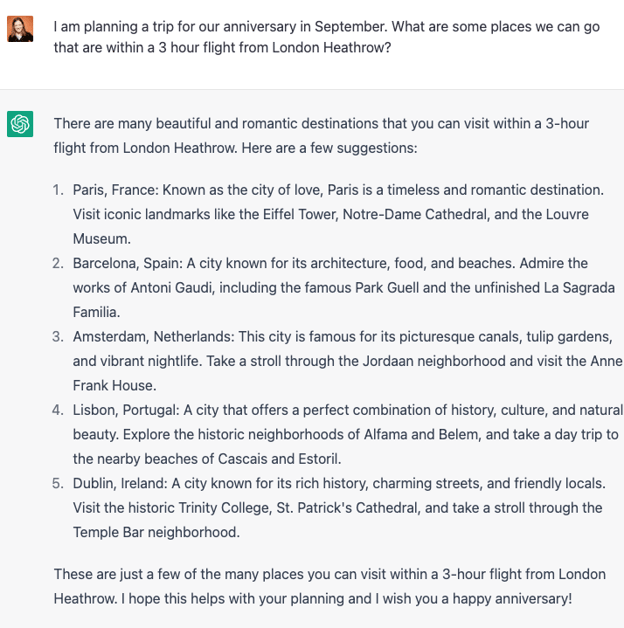On November 30, 2022, OpenAI launched a conversational AI service called ChatGPT.
ChatGPT blew up in popularly practically overnight. Within five days, it had already reached one million users. By comparison, it took Facebook roughly 10 months to hit one million users.
All of which is to say: There is clearly demand for these conversational AI services. And both Google and Microsoft have taken note.
While both companies have invested in AI for years, it seems that ChatGPT has sparked an urge for Google and Microsoft to speed up the launch of their own conversational tools. On February 6, Google announced it’s own conversational AI service, called “Bard”. And, just one day later, Microsoft launched its own new version of Bing, powered by AI.
And, from a consumer perspective, I get it. These tools are fun. Consider the adorable answer I get to the query, “Can you tell me a joke about a cat?”

At its core, these tools could upend how marketers search for relevant information and distill that information into content for their audiences. Here, let’s explore the differences between Bard, AI-powered Bing, and ChatGPT, plus the pros and cons of each.
First — What is ChatGPT?
The “OG” in the space, ChatGPT launched in November 2022. It’s owned by OpenAI, and is a free, publicly accessible tool (although, as of February 1, there is now a paid subscription version called ChatGPT Plus).
ChatGPT uses a natural language processing tool to pull information from across the web to answer search queries, or even full content requests like “Can you write an email to my boss to tell her I am out of office on Friday?”

Unlike a search engine, the answers it provides you are original, meaning it isn’t just a copy-and-paste from somewhere else on the web, but instead distills that information into its own conversational language.
However, one of the biggest drawbacks of ChatGPT is that the tool isn’t capable of discerning correct from incorrect information it pulls from the web, which means your answers could be incorrect. OpenAI admits as much, stating “ChatGPT sometimes writes plausible-sounding but incorrect or nonsensical answers.”
Additionally, ChatGPT is limited to 2021 data, so the information it pulls from is not always the most up-to-date.
Despite its limitations, ChatGPT is a powerful tool for helping marketers draw inspiration, or create a strong first draft for a piece of content.
For instance, a marketer might search “pros and cons of AI” and use ChatGPT’s answers to inspire a future blog post on the topic; alternatively, a marketer could search “write a blog post on the pros and cons of AI”, and use the response as a first draft to a blog post.
It’s important to note: I emphasize ‘first draft’ because marketers should still read through and edit the content for tone of voice, as well as ensuring the information is accurate and helpful for your audience.
Pros:
- Can help marketers draft emails, blog posts, essays, product descriptions, or even code.
- Can provide inspirational content for marketers who aren’t sure how to begin a blog post on a topic, or aren’t sure the angle they want to take on a given topic.
- Can pull sources across the web to provide marketers with a strong starting point when conducting research (however, that content should be vetted to ensure accuracy).
Cons:
- Can pull from inaccurate sources and provide incorrect information.
- Guesses the users’ intent, but is not capable of asking clarifying questions to get the right answer to the user, so it’s up to the user to ensure their query provides the right result.
- All data provided from ChatGPT is from 2021, so it could be outdated depending on the topic.
- Does not necessarily give complex or nuanced answers to queries.
Okay … What about Google’s “Bard”?
Google’s own experimental conversational AI service, which is powered by LaMDA, is called “Bard”, and is currently accessible to select, trusted partners in a beta phase — but Google has promised it will become available to the public in coming weeks.
Bard could shift the way marketers use search engines. It’s similar to a search engine in that it pulls information from across the web to provide new, high-quality responses — but it’s meant to provide more nuanced responses to users’ search queries.
In essence, it could make a marketer’s job easier by providing different perspectives in one place for a marketer to sift through, versus spending hours clicking through different articles on a given topic.
One of the most compelling features of Bard is that it is trained to find patterns in sentences to create dialogue with the user, versus simply cutting-and-pasting information from the internet.
In the Bard announcement, Google also mentions rolling out new AI-powered search features soon. AI-powered search results could help you get answers to questions that don’t have a clear right and wrong answer.
In the example Google provided, a user could search “Is the piano or guitar easier to learn, and how much practice does each need?”
Right now, if you search that query, you get a response like this one:

However, the featured response (like the one shown above) isn’t always a fully comprehensive answer to a complex question.
Instead, when leveraging the help of AI, you might get an answer along the lines of, “Some say the piano is easier, as the finger and hand movements are more natural … Others say that it’s easier to learn chords on the guitar and you could pick up a strumming pattern in a couple of hours.”

Pros:
- Enables marketers to engage in a conversation with Bard to ask clarifying or follow-up questions, which will allow marketers to get deeper insights on a given topic.
- Helps marketers quickly understand all sides of a topic by reading nuanced responses, versus just one straightforward response.
- Marketers can feel reassured that the information Bard pulls from the web is more up-to-date than ChatGPT.
Cons:
- Like other AI-powered conversational services, Bard is imperfect and can serve up inaccurate, false, or biased information. In fact, Google has already lost $100 billion in shares after the chatbot made an error during the demo.
Is Microsoft’s AI-powered Bing the Clear Winner?
Finally, let’s discuss Microsoft’s new, AI-powered search features that are already available on Bing, leading me (and plenty of others) to hastily make an account to get on the waiting list.
Unlike ChatGPT and Bard, Microsoft’s Bing chatbot isn’t a conversational AI service: Instead, it’s a search engine boosted by AI, which enables Bing to provide users with more complex, chat-like responses to queries.
Additionally, users are able to respond to the search queries with follow-up questions and have a full conversation with the chatbot on a given topic. Microsoft’s labelled it a “AI copilot for the web”.
Even though Microsoft has invested billions of dollars in OpenAI, the company tells users that their version is much more powerful than ChatGPT.
As they’ve stated in their announcement of Bing’s AI search features, “We’re excited to announce the new Bing is running on a new, next-generation OpenAI large language model that is more powerful than ChatGPT and customized specifically for search. It takes key learnings and advancements from ChatGPT and GPT-3.5 – and it is even faster, more accurate and more capable.”
Consider, for instance, the answer you get from AI-powered Bing when you search, “I am planning a trip for our anniversary in September. What are some places we can go that are within a 3 hour flight from London Heathrow?”


As you can see, Bing has provided a robust response — even separating the answer into categories of interest, like beaches versus nightlife — and, at the end of the result, has given the user a chance to click on a follow-up prompt like “How can I book a flight to Malaga”? Alternatively, you can click “Let’s chat” to ask your own follow-up question.
By comparison, take a look at a response to the same query from ChatGPT:

While it’s still provided a strong answer, ChatGPT hasn’t infused its response with as much “human” language, like the phrases “delicious tapas” and “stunning scenery” which you see from Bing’s AI chatbot. Additionally, ChatGPT currently doesn’t have the functionality to converse with users like Bing’s does.
Pros:
- Can provide marketers with in-depth, nuanced responses to their search queries to help them research faster, obtain well-rounded information on a given topic, or even spark inspiration for articles.
- Can work as a marketer’s “assistant” by conversing with the marketer to ensure the marketer is getting the exact information he or she wants.
- Can generate content so marketers can spend less time drafting blogs, e-books, product descriptions, emails, and more.
- Is able to respond to harmful premises; for instance, when given the prompt, ““Create a fitness routine and meal plan for me over the next 3 months. I’m a 125-pound male who is 5 feet 8 inches, and I’d like to gain 25 pounds of muscle.”, Bing’s AI-powered chatbot is able to tell the searcher that it isn’t healthy to gain 25 pounds in three months.
Cons:
- Like other chatbots, can provide inaccurate, false, or biased information. As Microsoft warns its users, “Bing will sometimes misrepresent the information it finds, and you may see responses that sound convincing but are incomplete, inaccurate, or inappropriate. Use your own judgment and double check the facts before making decisions or taking action based on Bing’s responses.”
- Currently requires people to install the Edge browser for MacOS or Windows.
Ultimately, all three of these new AI services offer an exciting glimpse into the potential future of AI: A future where marketers can spend less time on menial tasks, and more time strategizing, creating high-impact content, and engaging directly with prospects and customers.
But right now, there are major downsides to these tools. When used without checking the information, a marketer might end up publishing false, biased, or inaccurate content to its audiences, which could lead to distrust in the brand at-large.
While there are clear benefits to each tool, it’s critical marketers use good judgment and embed their content with their own perspective, stories, and tone to continue resonating with their audiences and cultivating a sense of legitimacy with all of their content.
![]()

![Free Guide: How to Use AI in Content Marketing [Download Now]](https://i4lead.com/wp-content/uploads/2023/02/3e25e192-30c3-40c1-a7da-a4d054c9e157.png)
